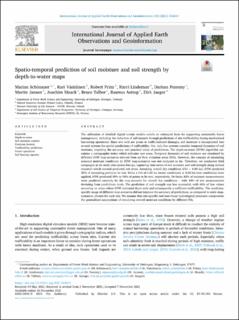| dc.contributor.author | Schönauer, Marian | |
| dc.contributor.author | Väätäinen, Kari | |
| dc.contributor.author | Prinz, Robert | |
| dc.contributor.author | Lindeman, Harri | |
| dc.contributor.author | Pszenny, Dariusz | |
| dc.contributor.author | Jansen, Martin | |
| dc.contributor.author | Maack, Joachim | |
| dc.contributor.author | Talbot, Bruce | |
| dc.contributor.author | Astrup, Rasmus Andreas | |
| dc.contributor.author | Jaeger, Dirk | |
| dc.date.accessioned | 2022-02-21T10:26:59Z | |
| dc.date.available | 2022-02-21T10:26:59Z | |
| dc.date.created | 2022-01-18T20:04:24Z | |
| dc.date.issued | 2021-11-16 | |
| dc.identifier.citation | International Journal of Applied Earth Observation and Geoinformation. 2021, 105 . | en_US |
| dc.identifier.issn | 1569-8432 | |
| dc.identifier.uri | https://hdl.handle.net/11250/2980440 | |
| dc.description.abstract | The utilization of detailed digital terrain models entails an enhanced basis for supporting sustainable forest management, including the reduction of soil impacts through predictions of site trafficability during mechanized harvesting operations. Since wet soils are prone to traffic-induced damages, soil moisture is incorporated into several systems for spatial predictions of trafficability. Yet, only few systems consider temporal dynamics of soil moisture, impeding the accuracy and practical value of predictions. The depth-to-water (DTW) algorithm calculates a cartographic index which indicates wet areas. Temporal dynamics of soil moisture are simulated by different DTW map-scenarios derived from set flow initiation areas (FIA). However, the concept of simulating seasonal moisture conditions by DTW map-scenarios was not analyzed so far. Therefore, we conducted field campaigns at six study sites across Europe, capturing time-series of soil moisture and soil strength along several transects which crossed predicted wet areas. Assuming overall dry conditions (FIA = 4.00 ha), DTW predicted 20% of measuring points to be wet. When a FIA of 1.00 ha (moist conditions) or 0.25 ha (wet conditions) were applied, DTW predicted 29% or 58% of points to be wet, respectively. De facto, 82% of moisture measurements were predicted correctly by the map-scenario for overall dry conditions – with 44% of wet measurements deviating from predictions made. The prediction of soil strength was less successful, with 66% of low values occurring on areas where DTW indicated dryer soils and subsequently a sufficient trafficability. The condition-specific usage of different map-scenarios did not improve the accuracy of predictions, as compared to static map-scenarios, chosen for each site. We assume that site-specific and non-linear hydrological processes compromise the generalized assumptions of simulating overall moisture conditions by different FIA. | en_US |
| dc.language.iso | eng | en_US |
| dc.publisher | Elsevier B.V. | en_US |
| dc.rights | Attribution-NonCommercial-NoDerivatives 4.0 Internasjonal | * |
| dc.rights.uri | http://creativecommons.org/licenses/by-nc-nd/4.0/deed.no | * |
| dc.title | Spatio-temporal prediction of soil moisture and soil strength by depth-to-water maps | en_US |
| dc.type | Peer reviewed | en_US |
| dc.type | Journal article | en_US |
| dc.description.version | publishedVersion | en_US |
| dc.rights.holder | © 2021 The Author(s) | en_US |
| dc.source.pagenumber | 11 | en_US |
| dc.source.volume | 105 | en_US |
| dc.source.journal | International Journal of Applied Earth Observation and Geoinformation | en_US |
| dc.identifier.doi | 10.1016/j.jag.2021.102614 | |
| dc.identifier.cristin | 1984133 | |
| dc.relation.project | EC/H2020/720757 | en_US |
| dc.source.articlenumber | 102614 | en_US |
| cristin.ispublished | true | |
| cristin.fulltext | original | |
| cristin.qualitycode | 1 | |

